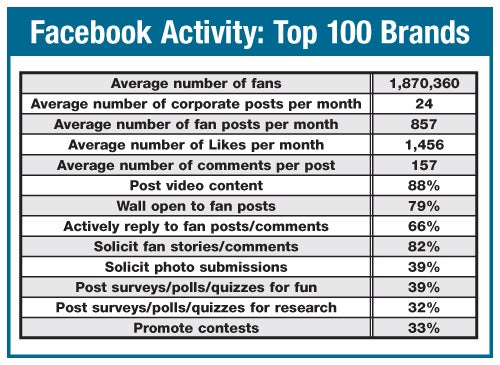A study released last month by WongDoody finds some untapped opportunities for organizations to do more communication through Facebook.
The marketing agency tracked the Facebook activities of Interbrand’s top 100 brands. While most have a Facebook listing, only 84 actually have a corporate-run page. And the companies seem cautious about how much they allow fans to participate and are limiting engagement, with 39% soliciting photo submissions; 33% promoting contests; 39% posting polls and quizzes for fun; and 32% posting surveys to gain consumer feedback.
In the wake of the announcement that PR News is holding its first Facebook Conference, set for May 24 in New York City, we decided to ask three conference presenters to weigh in on the study, but more importantly, to impart how they are maximizing their own organizations’ (and their clients’) Facebook communications for maximum returns.
For Arlene McCrehan, senior director of online media at Goodwill Industries International, it’s the disengagement of top brands with fans that’s surprising. More than 20% of these power players do not allow posting on their pages. “This closes off their brands from opportunities for engagement and nurturing,” says McCrehan. Even more surprising to McCrehan is the 34% of brands that do not reply to fans posts. “They are missing the opportunity to at least occasionally make a personal connection with their brand and build stronger relationships,” she says.
 |
| According to data collected by marketing agency WongDoody, while 84 of the top 100 brands have corporate Facebook pages, actual interaction with fans seems relatively low—with a third of the brands not replying to fan posts and comments. Source: WongDoody |
Christine Perkett, head of PerkettPR, found the average number of fans for the top 100 brands—1,807,360—to be low, considering how much communicators are investing in Facebook these days. Also, a lack of call-to-action data was frustrating. “Activity and call to action are not the same thing,” says Perkett. “What are communicators doing to correlate all of this activity to the bottom line for the business?”
And there lies the big challenge: linking Facebook results to the bottom line. “Taking Facebook metrics and mathematically assigning a dollar figure to the outreach is the most difficult part,” says Michael McManus, director of public relations at Sodexo. “If that correlation is done accurately, it can open up the door to additional resources.”
While proving Facebook ROI may be elusive, that isn’t stopping communicators from continuing to push the social media envelope. In the near future, Perkett forsees PR integrating Facebook activity to other hot strategies like mobile and location-based campaigns. “We’ll be grabbing users where they are but bringing them back to the Facebook community page to secure long-term brand fanatics,” says Perkett.
At Goodwill Industries, McCrehan sees an era of Facebook contests beginning, with plans to run two later this year. “They’ll revolve around user-generated content, and will be part of a multi-platform initiative,” she says. Meanwhile, McManus is focusing more on content in the internal sense—telling stories about Sodexo’s employees through social media, including Facebook. “We have 120,000 employees in North America alone, so that means we have 120,000 great stories to tell,” he says.
Clearly McManus has some posting to do. PRN
[Editor’s Note: Join McCrehan, Perkett, McManus and a host of other Facebook experts at the PR News Facebook Conference on May 24 in New York City. For information go to www.prnewsonline.com/conferences/facebookconference2011.html.]
CONTACT:
Arlene McCrehan, [email protected]; Christine Perkett, c/o [email protected]; Michael McManus, [email protected].
